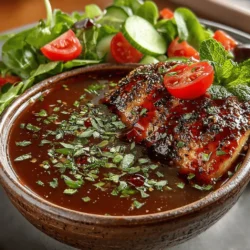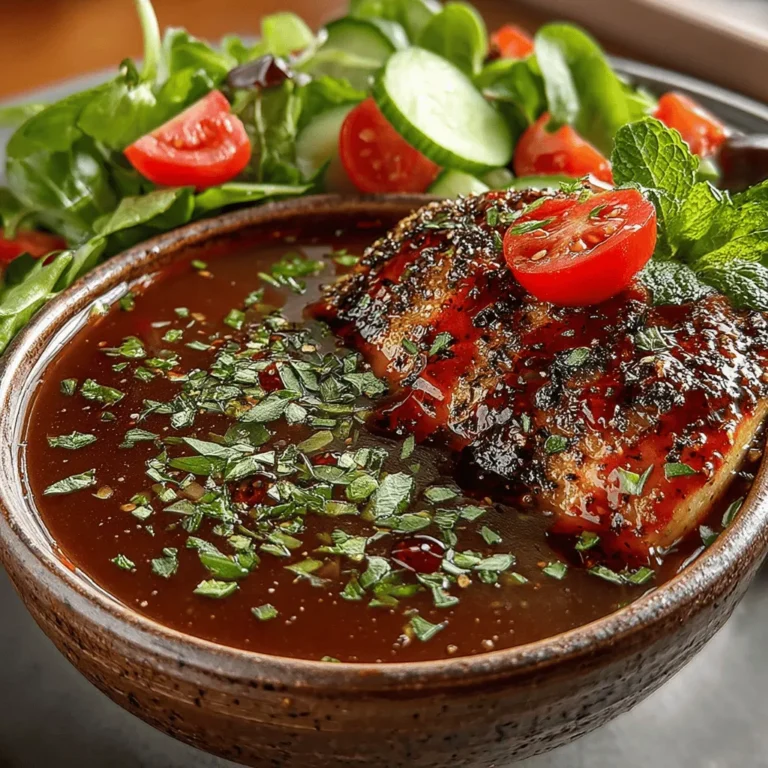Zesty Herb-Infused Fresh Balsamic Vinaigrette Recipe
Introduction
Salad dressings play a vital role in culinary culture, transforming simple greens into a delightful mélange of flavors that can tantalize the palate. They are not merely accompaniments; they are essential components that enhance the overall dining experience. Among the vast array of dressings available, balsamic vinaigrette stands out as a versatile and flavorful option that complements a wide variety of salads, grilled vegetables, and even meats. Its rich, tangy profile makes it a beloved choice for many home cooks and professional chefs alike.
While store-bought dressings offer convenience, they often fall short in flavor and quality. Many commercial options contain preservatives, unhealthy fats, and artificial flavors that detract from the freshness of the ingredients. In contrast, homemade dressings, like this Zesty Herb-Infused Fresh Balsamic Vinaigrette, provide an opportunity to control what goes into your food, emphasizing health and personalization. By preparing your own vinaigrette, you can adjust the flavors to suit your preferences, ensuring every meal is a celebration of freshness.
This zesty herb-infused balsamic vinaigrette is an easy recipe that elevates any dish with its vibrant taste and aromatic qualities. Whether drizzled over a crisp garden salad, used as a marinade for grilled chicken, or simply enjoyed as a dipping sauce, this dressing is sure to impress. The combination of herbs and the tang of balsamic vinegar creates a unique flavor profile that is both refreshing and satisfying.
Understanding the Ingredients
To create a truly exceptional vinaigrette, understanding the role of each ingredient is crucial. Here’s a closer look at the key components of this zesty herb-infused balsamic vinaigrette:
– Extra Virgin Olive Oil: The foundation of any vinaigrette, extra virgin olive oil is not only rich in flavor but also packed with health benefits. Its high monounsaturated fat content is heart-healthy, and it contains antioxidants that can reduce inflammation and promote overall well-being. When selecting olive oil, opt for high-quality, cold-pressed varieties for the best taste and nutritional value.
– Aged Balsamic Vinegar: This ingredient is essential for imparting the characteristic tanginess of the vinaigrette. Aged balsamic vinegar offers a complex flavor profile that is sweet and sour, adding depth to the dressing. The aging process allows the vinegar to develop richer notes, enhancing the overall taste of your vinaigrette.
– Dijon Mustard: A small but mighty addition, Dijon mustard not only adds a zesty kick but also acts as an emulsifier, helping to bind the oil and vinegar together. This creates a smooth and cohesive dressing that clings beautifully to your salad ingredients.
– Honey or Maple Syrup: To balance the acidity of the vinegar, a touch of sweetness is essential. Honey or maple syrup provides this balance, enhancing the vinaigrette’s overall flavor while keeping it natural. Both options offer their unique nuances, with honey lending a floral sweetness and maple syrup contributing a distinct, earthy quality.
– Garlic: Known for its robust flavor and numerous health benefits, garlic adds a savory note to the vinaigrette. It can enhance the dressing’s complexity and depth, making each bite more enjoyable. Additionally, garlic is renowned for its immune-boosting properties, making this vinaigrette not only tasty but also a healthy choice.
– Freshly Squeezed Lemon Juice: The addition of lemon juice brings brightness and acidity to the dressing, elevating the overall flavor profile. Freshly squeezed juice is preferred over bottled for its vibrant taste and nutritional benefits, including vitamin C.
– Dried Oregano and Basil: These herbs introduce aromatic notes that enhance the vinaigrette’s flavor. Dried oregano adds a slightly peppery taste, while basil contributes a sweet, fragrant element. Together, they create a harmonious blend that complements the other ingredients.
– Salt and Pepper: Essential for flavor enhancement, salt and pepper bring all the elements of the vinaigrette together. They ensure that each component shines through, creating a well-balanced dressing that elevates your salads and dishes.
Step-by-Step Instructions
Creating your own zesty herb-infused fresh balsamic vinaigrette is a straightforward process that can be completed in just a few simple steps. Here’s a detailed breakdown to guide you through the preparation:
1. Gather Your Ingredients: Start by assembling all the key ingredients on your countertop. You will need extra virgin olive oil, aged balsamic vinegar, Dijon mustard, honey or maple syrup, garlic, freshly squeezed lemon juice, dried oregano, dried basil, salt, and pepper.
2. Combine the Base Ingredients: In a medium-sized mixing bowl, add 1/2 cup of extra virgin olive oil and 1/4 cup of aged balsamic vinegar. Follow this with 1 tablespoon of Dijon mustard and 1 tablespoon of honey or maple syrup. Whisk these ingredients together vigorously to achieve a smooth mixture. The mustard will help emulsify the dressing, ensuring that the oil and vinegar blend seamlessly.
3. Incorporate the Herbal Notes: Next, add the freshly minced garlic (about 1 clove) and the freshly squeezed juice of half a lemon (approximately 1 tablespoon). Sprinkle in 1 teaspoon of dried oregano and 1 teaspoon of dried basil. Whisk again until the herbs are evenly distributed throughout the vinaigrette. This step is crucial for achieving a consistent flavor profile, as you want each bite to carry the essence of the herbs.
4. Season to Taste: Finally, season your vinaigrette with salt and freshly ground black pepper to taste. Begin with a pinch of each and adjust according to your preference. Taste the vinaigrette and make any necessary adjustments, adding more sweetness, acidity, or seasoning as desired.
With these steps, you have crafted a delightful zesty herb-infused balsamic vinaigrette that is ready to elevate your salads and dishes. This dressing not only enhances the flavors of your food but also provides a fresh, homemade touch that is sure to impress your family and friends. As you prepare to serve your vinaigrette, remember that its versatility allows it to be used in various culinary applications, making it a staple in your kitchen.
{{image_2}}
Creating the perfect vinaigrette is an art that balances flavor, texture, and freshness. In this section, we will delve into the techniques for emulsifying your vinaigrette, tips for seasoning, the benefits of allowing your dressing to rest, and the nutritional advantages of crafting your own dressings. We will also explore creative serving suggestions, storage tips, and conclude with thoughts on the joy of homemade dressings.
Emulsifying with Olive Oil: Techniques for Achieving the Desired Texture
To achieve the ideal texture for your zesty herb-infused balsamic vinaigrette, emulsification is key. Emulsification is the process of combining two ingredients that typically do not mix well, such as oil and vinegar. Here are some effective techniques to ensure your emulsification is successful:
1. Slow Addition of Oil: Start by adding the olive oil very slowly to the vinegar and herb mixture. This gradual incorporation allows the oil to disperse evenly, preventing separation. A good rule of thumb is to add the oil in a thin stream while whisking vigorously.
2. Use of a Blender or Food Processor: If you prefer a more uniform consistency, consider using a blender or food processor. Simply combine all your ingredients, including oil, and blend until fully emulsified. This method not only saves time but also ensures a creamy texture.
3. Mason Jar Shaking: For a quick and easy method, pour all your ingredients into a mason jar, seal it tightly, and shake vigorously. This method is particularly useful for those who enjoy making small batches, and it also doubles as a storage container.
4. Whisking by Hand: If you opt for the traditional method, use a whisk and a bowl. Start with the vinegar and herbs, and gradually whisk in the olive oil until the mixture thickens slightly and becomes glossy. This method gives you more control over the texture.
Using these techniques, you’ll achieve a well-emulsified vinaigrette that clings beautifully to your salads and other dishes.
Seasoning to Perfection: Tips for Tasting and Adjusting Flavors
Once your vinaigrette is emulsified, it’s time to season it to perfection. The beauty of homemade dressings lies in the ability to adjust flavors to suit your palate. Here are some tips for tasting and adjusting your vinaigrette:
1. Taste as You Go: After emulsifying, take a small spoonful to taste. This will help you assess the balance of acidity, sweetness, and herbiness. Remember, you can always add more, but you can’t take it away once it’s in.
2. Adjusting Acidity: If the vinaigrette tastes too tangy, consider adding a touch more honey or maple syrup to balance the acidity. Conversely, if it’s too sweet, a splash more balsamic vinegar will enhance the tanginess.
3. Enhancing the Herb Flavor: If you feel the herb flavors need a boost, add more of your fresh herbs gradually. Herbs like basil, parsley, or oregano can be added to taste, enhancing the freshness of your dressing.
4. Salt and Pepper: Don’t forget to season with salt and freshly cracked black pepper. Start with a pinch of salt, mix, and taste again. The right seasoning will elevate your vinaigrette and make all the flavors pop.
5. Experiment with Spices: For a unique twist, consider adding a pinch of spices such as red pepper flakes for heat, or a dash of garlic powder for added flavor. These small adjustments can create a vinaigrette that perfectly matches your dish.
By carefully tasting and adjusting, you ensure your vinaigrette is tailored to your preferences, making it all the more enjoyable.
Resting for Flavor Development: Explaining the Importance of Letting Flavors Meld
One of the most important steps in creating a delicious vinaigrette is allowing it to rest. This resting period is crucial for flavor development and enhances the overall taste of your dressing. Here’s why letting your vinaigrette sit is beneficial:
1. Flavor Intensification: When the vinaigrette sits, the flavors have time to meld together, creating a more harmonious blend. This is particularly important for fresh herbs, which can release their essential oils and infuse the dressing with depth.
2. Texture Improvement: Resting can also improve the texture of your vinaigrette. The ingredients may thicken slightly, resulting in a creamier dressing that adheres beautifully to your salad greens.
3. Refrigeration: Allow your vinaigrette to chill in the refrigerator for at least 30 minutes before serving. If time permits, letting it sit for a few hours or overnight can significantly enhance the flavor profile.
4. Stir Before Serving: After the resting period, give your vinaigrette a good shake or stir before using. This will re-emulsify any ingredients that may have separated and ensure a consistent flavor throughout.
By allowing your vinaigrette to rest, you maximize its potential, creating a dressing that is both flavorful and pleasing in texture.
Nutritional Benefits of Homemade Dressings
Homemade dressings, like this zesty herb-infused balsamic vinaigrette, come with numerous nutritional advantages compared to store-bought alternatives. Here’s a closer look at the benefits:
1. Fresh Ingredients: By using fresh herbs, high-quality olive oil, and natural sweeteners, you can create a dressing that is rich in vitamins, antioxidants, and healthy fats. Fresh ingredients not only taste better but also contribute to a healthier diet.
2. Calorie Transparency: Homemade dressings allow you to have complete control over the ingredients and their quantities. Store-bought dressings often contain preservatives, artificial flavors, and added sugars that can significantly increase calorie counts. By making your own, you can keep it light and nutritious.
3. Healthy Fats: Olive oil is a key ingredient in this vinaigrette and is known for its heart-healthy monounsaturated fats. These fats can help reduce inflammation, lower cholesterol levels, and promote better heart health.
4. Natural Sweeteners: This recipe uses honey or maple syrup as a natural sweetener, avoiding the refined sugars found in many commercial dressings. These natural options add sweetness while providing additional nutrients.
5. Customizable Nutrition: Making your own dressing allows you to tailor it to your dietary needs. Whether you are looking to reduce sugar, increase healthy fats, or add specific herbs for their health benefits, the possibilities are endless.
Overall, opting for homemade dressings not only enhances flavor but also promotes a healthier lifestyle.
Serving Suggestions
The versatility of your zesty herb-infused balsamic vinaigrette extends far beyond just salads. Here are some creative serving suggestions to elevate your meals:
1. Pairing with Grilled Vegetables: Drizzle the vinaigrette over grilled vegetables such as zucchini, bell peppers, and asparagus. The acidity of the dressing complements the charred flavors, enhancing the dish’s depth.
2. Marinade for Meats: Use the vinaigrette as a marinade for chicken, pork, or fish. The acid from the vinegar will tenderize the meat while infusing it with flavor before cooking. Marinate for at least 30 minutes for optimal results.
3. Roasted Potatoes: Toss roasted potatoes with the vinaigrette right before serving. The warm potatoes will absorb the dressing, adding a zesty kick to this simple side dish.
4. Grain Bowls: Drizzle the vinaigrette over grain bowls that include quinoa, brown rice, or farro. Adding fresh vegetables, nuts, and protein will create a nutritious and satisfying meal.
5. Presentation Ideas: For a visually appealing serving experience, consider serving the vinaigrette in a small glass jar or a stylish cruet. Pair it with a fresh salad on a colorful plate or bowl to create an eye-catching presentation.
These serving suggestions will not only highlight the versatility of your vinaigrette but also inspire you to explore new flavors and combinations.
Storage Tips
To make the most of your homemade zesty herb-infused balsamic vinaigrette, proper storage is essential. Here are some best practices to ensure freshness and longevity:
1. Refrigeration: Store your vinaigrette in an airtight container in the refrigerator. A glass jar or a well-sealed bottle works well to prevent air exposure, which can degrade the flavors.
2. Shelf Life: Generally, homemade vinaigrettes can last for about 1 to 2 weeks in the refrigerator. However, always check for any changes in smell or appearance before using.
3. Separation is Normal: Due to the nature of emulsified dressings, separation may occur after storage. Simply give it a good shake or stir before using to re-emulsify the ingredients.
4. Revitalizing After Storage: If you find the vinaigrette has lost some of its vibrancy after being stored, consider adding a splash of fresh balsamic vinegar or a bit more olive oil to brighten the flavors. Taste and adjust as necessary.
By following these storage tips, you can ensure your vinaigrette remains fresh and flavorful, ready to enhance your meals whenever you need it.
Conclusion
In conclusion, the zesty herb-infused balsamic vinaigrette is a simple yet versatile dressing that can elevate a variety of dishes. With easy emulsification techniques, the importance of tasting and adjusting flavors, and the benefits of resting for flavor development, you can create a dressing that is not only delicious but also nutritious.
The advantages of using fresh ingredients and natural sweeteners make homemade dressings a healthier option compared to their store-bought counterparts. With creative serving suggestions and proper storage tips, you can enjoy this vinaigrette in numerous ways, from salads to marinades and beyond.
We encourage you to experiment with variations of this recipe to suit your taste and preferences. Discover the joy of creating homemade dressings and how they can enhance your meals with fresh, vibrant flavors. Embrace the art of vinaigrette-making and enjoy a healthier, tastier dining experience!


